Bulletin – September 2012 The Chinese Banking System
- Download the article 208KB
Abstract
The Chinese banking system is critical to the functioning of the Chinese economy, being the main conduit through which savings are allocated to investment opportunities. Banking activity in China has grown rapidly over the past decade in association with the expansion of the Chinese economy, and the Chinese banking system now includes some of the world's largest banks. Chinese banks have become more commercially orientated over this period, although the Chinese Government retains considerable influence over their activities. This article examines the size and structure of the Chinese banking system and the key characteristics of banking activity in China. The regulatory and institutional arrangements for banking in China are also outlined.
Size and Structure of the Chinese Banking System
The Chinese banking system is large relative to the size of the Chinese economy and has expanded significantly over the past decade. Consolidated banking system assets (including assets in Chinese banks' foreign branches and subsidiaries) were equivalent to around 240 per cent of GDP at the end of 2011, up from around 200 per cent in the early 2000s (Graph 1). Domestic credit is estimated to be equivalent to 145 per cent of GDP. This credit-to-GDP ratio is high relative to countries with similar levels of per capita income (IMF 2011a). Other funding sources in China are less developed than intermediated credit: debt securities outstanding (excluding central government and central bank debt) and equity market capitalisation are each equivalent to around 30–40 per cent of GDP.[1]
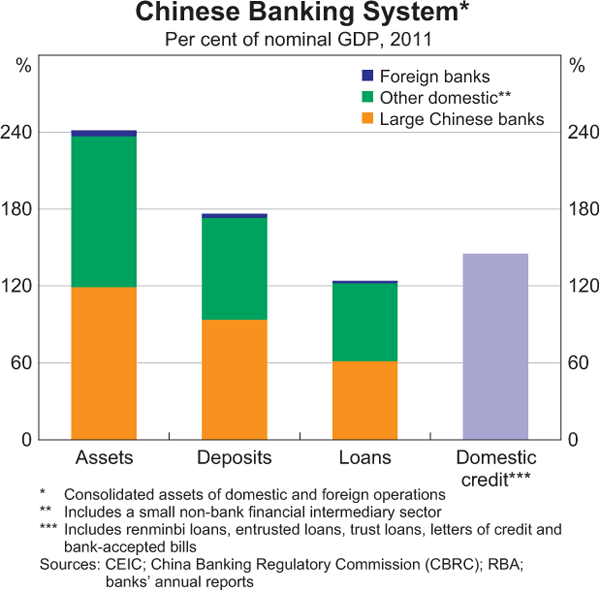
The five largest banks in China are, in order of decreasing size, Industrial and Commercial Bank of China (ICBC), China Construction Bank (CCB), Bank of China (BOC), Agricultural Bank of China (ABC) and the Bank of Communications (BCOM). Together these banks account for around one half of Chinese banking system assets and deposits. These banks are majority-owned by the Chinese state, but have private sector shareholders through their listings on the Hong Kong stock exchange. (See Box A for background on the evolution of the Chinese banking system, including the restructuring and public listing of the largest Chinese banks.) They are also among the largest banks globally; according to The Banker (2012), by assets they were ranked 5th, 12th, 13th, 15th and 37th in the world in 2011. Furthermore, BOC has been classified as a global systemically important bank by the Financial Stability Board (FSB 2011).[2]
Box A: Evolution of the Modern Chinese Banking System
Prior to the late 1970s, the Chinese banking system consisted of only one bank – the People's Bank of China (PBC). The PBC was part of the Ministry of Finance and its role in China's planned economy was primarily to collect revenues from state-owned enterprises and allocate investment funds approved through the budget (Jiliang 2004; Pei and Shirai 2004; Walter and Howie 2011).
The modernisation of the Chinese banking system began in 1978 with the establishment of three specialised banks: the ABC assumed rural banking activities from the PBC; BOC became responsible for foreign currency transactions and international business; and CCB focused on servicing the construction industry. In 1984, the ICBC was established to take over industrial and commercial banking activities from the PBC, which subsequently began to act as China's central bank and financial sector supervisor. The Chinese Government also permitted the establishment of a number of other domestic banking institutions from the late 1980s, including BCOM. In an effort to separate policy-related lending from commercial banking in China, three policy banks were created in the mid 1990s (China Development Bank, Import and Export Bank of China, and Agricultural Development Bank of China), and a law was enacted establishing the four specialised banks (ABC, BOC, CCB and ICBC) as state-owned commercial banks responsible for managing their own operations and risks, in accordance with prudential regulations.
The moves to commercialise the Chinese banks occurred against a backdrop of earlier misdirected lending and poor bank performance. Much of the Chinese banks' lending during the late 1980s and 1990s was to state-owned enterprises, many of which were loss-making and reliant on bank credit to continue financing their activities, but ultimately did not repay these loans (Lardy 1999). Bank lending had also contributed to a boom and subsequent bust in the real estate and stock markets in the early 1990s (Huang 2006). As a result, banks' non-performing loans increased significantly: by the late 1990s the large state-owned banks' aggregate non-performing loan (NPL) ratio exceeded 30 per cent (Huang 2006).[1a] These banks were severely undercapitalised at this time (relative to minimum international regulatory standards) and had only small loan loss provisions (Lardy 1999).[2a]
The Chinese Government commenced an extended process of restructuring the four largest state-owned Chinese banks in 1998, injecting a total of US$33 billion of capital into them, financed by the sale of bonds to the same banks (Table A1). Four asset management companies (AMCs) were then established in 1999, one for each bank. These AMCs were tasked with purchasing, resolving and selling the banks' NPLs. The AMCs purchased US$168 billion of NPLs in 1999–2000, at face value, which they partly financed by selling (low-yielding) bonds to the banks. Only loans originated prior to 1996 were purchased by the AMCs because the performance of loans originated after that date was deemed to be a consequence of banks' own credit decisions rather than government policy (Peiser and Wang 2002; Pei and Shirai 2004).
| BOC | CCB | ICBC | ABC | Total | Memo: share of banks' assets(a) |
|
|---|---|---|---|---|---|---|
| Per cent | ||||||
| Initial capital injection in: |
1998 | 1998 | 1998 | 1998 | ||
| US$ billion | 5 | 6 | 10 | 11 | 33 | 3½ |
| Initial NPL disposal in:(b) |
1999–2000 | 1999–2000 | 1999–2000 | 1999–2000 | ||
| US$ billion | 32 | 45 | 49 | 42 | 168 | 15½ |
| Subsequent capital injection in: |
2003 | 2003 | 2005 | 2008 | ||
| US$ billion | 23 | 23 | 17 | 19 | 81 | 3½ |
| Subsequent NPL disposal in:(c) |
2004 | 2004 | 2005 | 2008 | ||
| US$ billion | 33 | 15 | 86 | 117 | 252 | 8 |
| Establish shareholding company in: | 2004 | 2004 | 2005 | 2009 | ||
| IPO in: | 2006 | 2005 | 2006 | 2010 | ||
| US$ billion | 13 | 17 | 22 | 22 | 74 | 2 |
|
(a) Simple average of the four banks' shares at their respective times Sources: Liu (2004); Ma and Fung (2002); banks' annual reports |
||||||
All four banks underwent further recapitalisation and disposal of NPLs in the 2000s, and were subsequently listed on the Hong Kong and Shanghai stock exchanges. The four banks' initial public offerings (IPOs) raised a combined US$74 billion in return for around 15–25 per cent of these companies' equity; the IPOs of ICBC and ABC were the largest recorded in the world at the time. Some large global banks became strategic minority shareholders in the state-owned Chinese banks, assisting their commercialisation.
China has undertaken a number of other banking system reforms in addition to restructuring its largest banks. Upon joining the World Trade Organization in 2001, China agreed to a five-year timetable of changes aimed at opening up its banking system to foreign competition; by 2006, locally incorporated foreign-owned banks were allowed to apply for a licence to offer unrestricted local currency services to Chinese individuals. In 2003, the China Banking Regulatory Commission (CBRC) was established to assume responsibility for banking sector regulation and supervision, separating this from the functions of monetary policy and financial system stability that continued to reside with the PBC. The CBRC has been active in strengthening prudential standards and oversight over recent years, contributing to improvements in governance, risk management practices and transparency among Chinese banks. For example, large commercial banks in China now have independent directors on their boards, as well as independent risk management functions, and make regular financial disclosures. China is also an important part of the international financial regulatory community via its membership of the G-20, FSB and Basel Committee on Banking Supervision (BCBS). The Chinese authorities intend to start implementing the Basel III international bank capital standards from the start of 2013 – the beginning of the internationally agreed phase-in period for these standards.
The Chinese banking system was resilient to the direct financial effects of the 2008–2009 global financial crisis, in large part because it was focused on a strongly growing domestic market and had little exposure to overseas wholesale funding markets. In response to the sharp downturn in external demand, the Chinese authorities implemented substantial economic stimulus through a rapid expansion in bank credit, which was largely directed to government infrastructure projects. The increase in banks' credit in 2009 was equivalent to about 30 per cent of GDP. The sizeable amount of government-mandated lending is likely to have slowed the ongoing commercialisation of the Chinese banks, and may have added to their credit risks.
The rest of the Chinese banking system is mostly accounted for by other domestically owned banks. This group includes 12 smaller listed commercial banks, three ‘policy’ banks, a postal savings bank, more than one hundred ‘city commercial’ (regional) banks, and around three thousand small credit cooperatives and rural financial institutions. There is also a small, but fast-growing, non-bank financial intermediary sector that includes finance companies and trust companies. Foreign-owned banks, in aggregate, represent only a small part of the Chinese banking system, at less than 2 per cent of total assets. This is despite there being 37 locally incorporated foreign banks and 77 foreign banks operating under a branch licence at the end of 2011. Foreign banks have been unable to penetrate the Chinese market beyond this small share because they have had difficulty competing for domestic customers on price, quantity and product, and have faced regulatory restrictions on some activities. For example, foreign banks face restrictions when applying for a licence to provide local-currency services to Chinese individuals, engage in derivatives transactions or issue renminbi bonds.
Institutional and Regulatory Arrangements
The institutional and regulatory arrangements for banking in China differ from those in many other banking systems. The Chinese Government is still extensively involved in the banking system through its majority ownership of the largest Chinese banks and the Chinese authorities retain considerable influence over banks' lending and deposit-taking activities. These arrangements mean that incentives within the Chinese banking system differ from those in banking systems that are predominantly privately owned and controlled.
The Chinese Government has majority ownership of banks that account for more than half of Chinese banking system assets, mainly through equity stakes of around 60–90 per cent in each of the five largest commercial banks. The government's equity shareholdings are owned by Central Huijin (a subsidiary of the sovereign wealth fund, China Investment Corporation, which invests in financial institutions), the Ministry of Finance and, to a lesser extent, some state-owned enterprises. In addition, the government is the sole owner of the three policy banks and has controlling stakes in a number of smaller commercial banks. As majority owner, the Chinese Government appoints the senior management of these banks.
The PBC conducts monetary policy in a managed exchange rate environment; it sets explicit targets for growth in the money supply and guides both the quantity of bank lending and its distribution across sectors of the economy. Bank lending decisions in China can therefore sometimes reflect government policy priorities rather than purely commercial considerations. Consistent with this, a significant (and disproportionate) share of bank credit in China is extended to state-owned enterprises and government infrastructure projects.
Reserve requirement ratios (RRRs) are one of the tools used by the PBC to control the supply of money in the Chinese banking system.[3] The RRR is the proportion of deposits a bank must hold as reserves with the central bank; these funds are not available to be lent out to customers or invested. In recent years, RRRs have been adjusted to largely offset the effect on money and credit of the injections of liquidity associated with the government's foreign exchange operations. Currently, the benchmark RRRs are 20 per cent for large banks and 18 per cent for most smaller banks. However, under its policy of ‘dynamic differentiated reserve requirements’ introduced in early 2011, the PBC can tailor RRRs to individual banks according to their holdings of capital and their rate of credit growth. This policy aids the PBC's influence over lending to particular sectors or industries – for example, RRRs were lowered for some branches of ABC earlier this year to boost lending in rural areas. Chinese banks' reliance on deposit funding, coupled with low remuneration on required reserves, means that high RRRs impose a large opportunity cost on banks. Moreover, as RRRs must be met on a daily basis (based on a 10-day rolling average of the stock of deposits), banks tend to hold a buffer of excess reserves – across the system this buffer averaged 1½ per cent of deposits during 2011.[4]
The PBC also sets benchmark interest rates on banks' deposits and loans at various maturities (Table 1). Benchmark deposit rates have constituted a ceiling on actual deposit rates, except for large-value deposits, for which banks are permitted to pay higher rates. In contrast, benchmark lending rates have generally placed a floor on actual lending rates, and over the past couple of years an increasing share of bank loans have been priced above benchmark rates. This situation has ensured the profitability of Chinese banks' intermediation activities, given that non-deposit funding represents only a small part of their funding liabilities. In June and July 2012, the Chinese authorities announced that actual rates on all bank deposits were permitted to exceed the relevant benchmark by up to 10 per cent, while lending rates could be as much as 30 per cent below benchmark (previously a 10 per cent discount was allowed).[5] Analysts have speculated that this additional interest rate flexibility will result in the compression of margins at some Chinese banks, to the extent that banks take the opportunity to raise deposit rates in an environment of slower deposit growth. According to PBC (2012), most commercial banks have responded by raising their demand and 1-year deposit rates above benchmark levels, often by the full 10 per cent allowed.
The CBRC requires banks to satisfy a number of quantitative controls on their balance sheets, in addition to imposing minimum capital requirements in line with international regulatory norms. These include: a maximum loan-to-deposit ratio of 75 per cent; a minimum liquidity ratio (liquid assets/current liabilities) of 25 per cent; and a minimum provision coverage ratio (provisions/non-performing loans) of 150 per cent. These regulatory ratios are set at conservative levels, which should contribute to greater bank soundness, all else being equal. On the other hand, history elsewhere has shown that strict quantitative regulations can have unintended effects – for example, required loan-to-deposit ratios might lead banks to invest in non-loan assets that prove riskier than their traditional loan business. More generally, banks may take actions to circumvent regulations, including through their off-balance sheet activities.
| Deposit | Lending | |
|---|---|---|
| Demand | 0.35 | na |
| 3-month | 2.60 | na |
| 6-month | 2.80 | 5.60 |
| 1-year | 3.00 | 6.00 |
| 2-year | 3.75 | na |
| 3-year | 4.25 | 6.15 |
| 5-year | 4.75 | 6.40 |
| > 5-year | na | 6.55 |
|
Source: CEIC |
||
Characteristics of Banking Activity
The Chinese banking system is largely focused on traditional financial intermediation between savers and borrowers in China. Consistent with this, around two-thirds of Chinese banks' income comes from these activities (CBRC 2011). Chinese banks largely fund themselves from domestic deposits (around 70 per cent of system liabilities); the share of banks' funding sourced from debt capital markets is fairly small (Table 2). About half of banks' deposits are from non-financial corporations, with households accounting for most of the remainder. By maturity, around 45 per cent of banks' deposits are held on demand; this share appears to be higher for the five largest commercial banks (Graph 2).
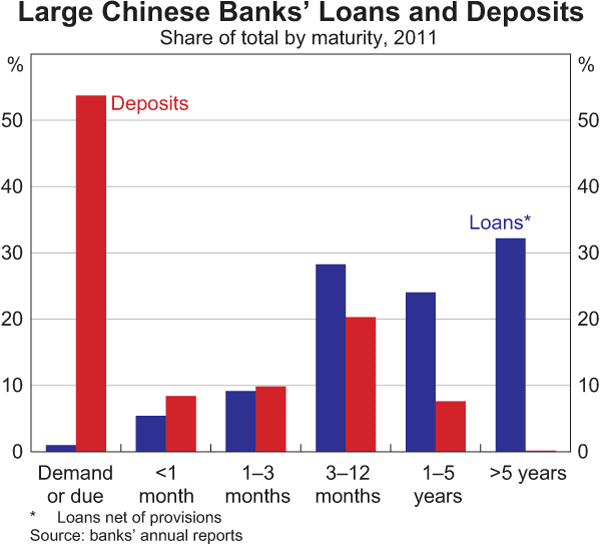
On the asset side, domestic loans represent around 50 per cent of banking system assets. The majority of banks' loans are to large and medium-sized non-financial corporations (including state-owned enterprises). Loans to small businesses account for around 20 per cent of loans, while household loans account for less than one-quarter of banks' total loans – a lower share than in many other banking systems, including those elsewhere in Asia.
| Assets | Liabilities | |||
|---|---|---|---|---|
| Share of total assets | Share of total liabilities | |||
| Foreign assets | 2.5 | Foreign liabilities | 0.8 | |
| Reserve assets | 14.1 | Liabilities to central bank | 0.8 | |
| Claims on government | 5.6 | Bonds issued | 6.7 | |
| Other claims(a) | 73.3 | Liabilities to corporations and households |
80.3 | |
| Non-financial corporations | 40.0 | Non-financial corporations | 33.5 | |
| Households | 11.5 | Households | 31.2 | |
| Other financial corporations | 21.8 | Other financial corporations | 13.3 | |
| Other sectors | 2.3 | |||
| Other | 4.5 | Other(b) | 11.4 | |
| Total | 100.0 | Total | 100.0 | |
| Memo items | ||||
| Loans for domestic use | 46.9 | Total deposits | 69.6 | |
| Local currency loans | 47.0 | Corporate deposits(c) | 34.1 | |
| Foreign currency loans | 2.9 | Household deposits | 31.2 | |
|
(a) Includes loans, bonds, equities and other financial derivatives Source: CEIC |
||||
System-wide data from the PBC and more disaggregated data from the five largest commercial banks indicate that banks' loans are fairly evenly spread between short-term maturities (i.e. less than one year), medium-term maturities (1–5 years) and long-term maturities (greater than five years) (Graph 2). The average term of banks' lending has increased steadily since the early 2000s, driven by increased investment project financing (IMF 2011b). This has increased the maturity mismatch between banks' loans and deposits. While this mismatch exposes Chinese banks to funding liquidity risks (as is typically the case for banks), a lack of investment alternatives for most depositors and the high government ownership stake in Chinese banks are two factors that arguably contribute to the stability of banks' sizeable short-term deposit base. In addition, the Chinese banks hold a large stock of liquid assets, which can act as a buffer against cashflow shortfalls in the near term.
Banks' non-loan assets mostly include their holdings of debt securities. Most of these are issued by government (largely the central government and the PBC) and ‘other financial corporations’, although banks also hold a small amount of non-financial corporate debt securities. In addition, the four largest commercial banks hold bonds relating to the financing of their previous restructuring; these bonds were about 3 per cent of their assets at the end of 2011. Around 15 per cent of banks' assets are held as central bank reserves, reflecting the PBC's reserve requirements plus a small buffer of excess reserves.
The foreign assets of the Chinese banking system are relatively small. These assets are mainly held by the five largest Chinese banks, which operate in numerous foreign markets.[6] Nonetheless, with the exception of BOC (22 per cent), the share of these banks' foreign assets in total assets is low (1–7 per cent), and well below that of large banks from other countries.
Chinese commercial banks have maintained strong profitability over recent years, recording aggregate after-tax returns on equity of 15–20 per cent per annum (Graph 3). Profit growth has been supported by rapid expansion in banks' lending over this period (Graph 4). Banks have been able to largely fund this increased lending through deposit growth, which has been supported by robust economic conditions and high saving rates in China. Chinese banks' recent returns are well above the rates recorded during the early 2000s, which were less than 5 per cent. The pick-up in banks' profitability in recent years has been driven by a marked reduction in non-performing loans and improvements in cost management.
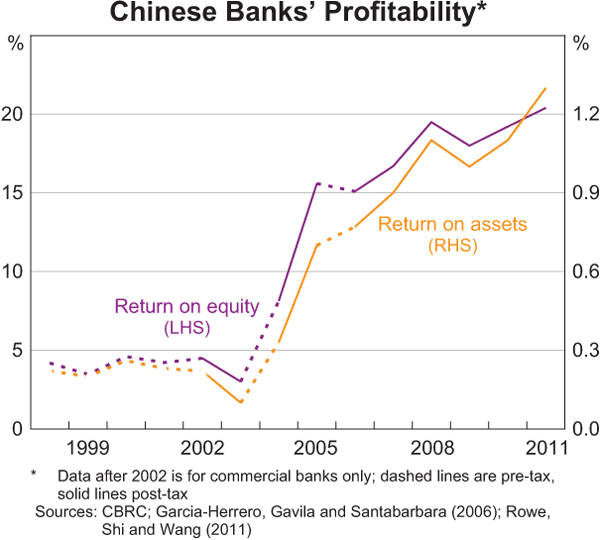
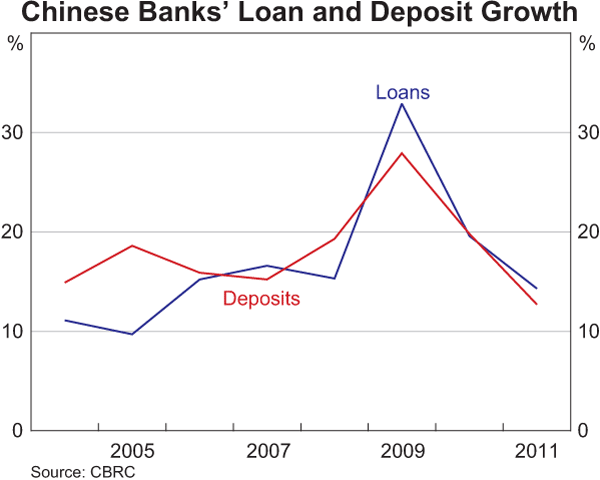
An indicator of the average profitability of Chinese banks' interest-earning activities is provided by their net interest margins, which have remained at fairly high levels of about 2½–3 per cent over recent years. As shown in Table 1, the regulation of deposit and lending rates in China means that Chinese banks benefit from high average spreads on their intermediation activities. Chinese banks' actual net interest margins are well below the spreads between benchmark loan and deposit rates, however, reflecting the low returns actually earned on their reserve assets held with the PBC and their holdings of debt securities.
The performance of Chinese banks' loan portfolios has continued to improve since the phased removal of NPLs from the largest banks' balance sheets between 2004 and 2008 (see Box A). The aggregate NPL ratio for commercial banks declined from 2.4 per cent at the end of 2008 to 1.0 per cent at the end of 2011; the comparable ratio for the entire banking system was higher at 1.8 per cent (Graph 5). By sector, the NPL ratio on commercial banks' residential mortgage loans (0.3 per cent) was much lower than on their corporate loans (1.1 per cent) and personal loans (1.1 per cent). The relatively low NPL ratio for residential mortgages accords with international experience, but might have been assisted by conservative home lending standards and low household indebtedness in China.[7]
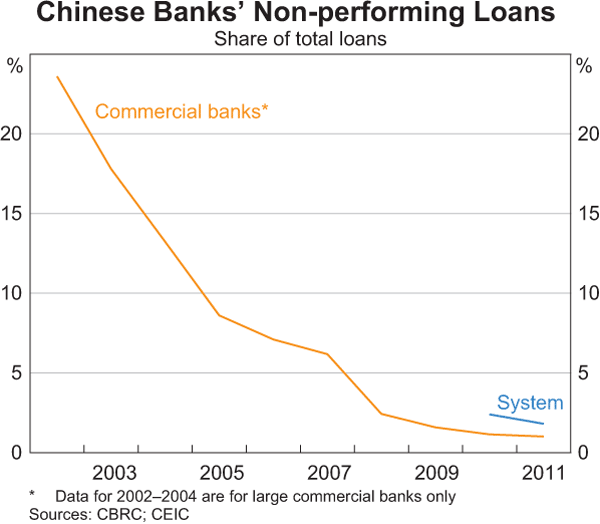
The improvement in banks' loan performance over the past few years has coincided with a period of strong growth in nominal incomes and credit in China. This has added a large portion of new loans, which tend to have relatively low rates of non-performance, to the total stock of credit. Some commentators have expressed concerns about how Chinese banks' loan portfolios will perform in the event of less favourable economic and financial conditions. The prospective performance of loans made during the policy-induced surge in lending in 2009 is also a source of concern.
Even so, over recent years Chinese banks have significantly strengthened their provision and capital buffers, which should help them deal with any future increase in problem loans or other adverse shocks. In response to rapid credit growth, the CBRC raised banks' minimum provision coverage ratio – provisions as a share of NPLs – from 100 per cent to 150 per cent over 2009–2010; it also required banks' provisions to be no lower than 2½ per cent of total loans. By the end of 2011, commercial banks' aggregate provision coverage ratio had risen to about 280 per cent (Graph 6). Chinese commercial banks' total capital ratio increased from about 8½ per cent in 2007 to 12.7 per cent at the end of 2011.[8] Around 80 per cent of banks' capital at the end of 2011 was in the form of ‘core’ capital – that is, capital instruments with the greatest ability to absorb losses. The strengthening in Chinese commercial banks' capitalisation during this period was partly due to ABC's receipt of government capital in 2008 and its IPO in 2010. Strong earnings growth has also helped commercial banks accumulate capital over recent years, although the effect on their capital ratios has been partly offset by fast growth in risk-weighted assets. Overall, Chinese commercial banks' aggregate capital ratio remains well above minimum international regulatory standards, but below those observed in most other emerging market banking systems, including those in the Asian region.
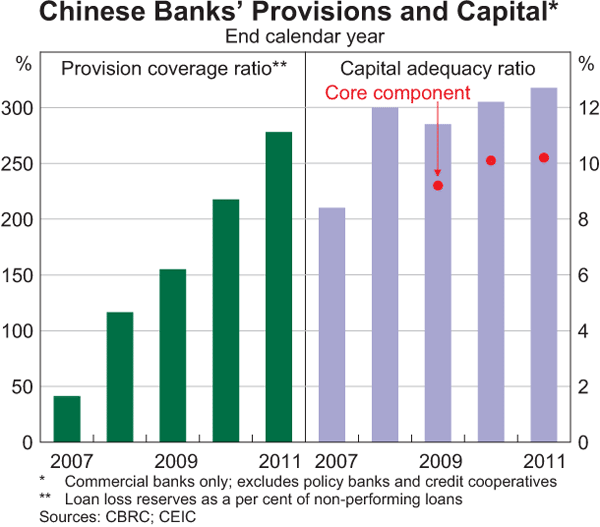
Banks' off-balance sheet activities have been growing strongly in association with tighter quantitative controls on balance sheets. Chinese banks' off-balance sheet activities generate fee income and include their contingent liabilities (such as bank-accepted bills, entrusted loans, and letters of credit), as well as the sale of wealth management products (WMPs).[9]
Issuance of WMPs has grown sharply over the past few years given the very low returns offered by deposits; according to PBC estimates, the stock of commercial banks' off-balance sheet WMPs grew by 46 per cent over the year to September 2011, to CNY3.3 trillion (equivalent to 4 per cent of commercial banks' total assets in 2011). In response to the growth in some off-balance sheet activities and concerns that they have been used to circumvent banking regulations, the Chinese authorities have taken a number of regulatory actions, including requiring banks to: bring their trust lending activities back onto their balance sheets; incorporate deposits placed by firms seeking bank-accepted bills or letters of credit in their reserve requirement calculations; and improve their disclosure to investors of the risks associated with WMPs. The authorities have also imposed capital requirements on trust companies.
Conclusion
Over the past few decades the Chinese banking system has evolved from a monobank system to a more commercially orientated banking system governed by a stand-alone supervisor and a central bank. The system now includes five of the world's largest commercial banks and numerous other smaller commercial banks and institutions. The banking system is large relative to the Chinese economy and dominates capital allocation in China. The Chinese Government continues to be substantially involved in the banking system through its majority ownership of the largest banks, and the Chinese authorities retain considerable influence over banks' lending and deposit-taking activites. Chinese banks largely fund themselves from domestic deposits and lend primarily to large and medium-sized domestic businesses, including state-owned enterprises. Chinese banks' profitability and capitalisation have improved considerably over the past decade, as have standard measures of asset performance. These improvements have occurred in an environment of strong growth in nominal incomes and credit in China. It is unclear how the Chinese banking system will perform in a less favourable environment.
Footnotes
Grant Turner and Nicholas Tan are from Financial Stability Department; Dena Sadeghian is from Economic Group. [*]
The comparison between the bank credit and the debt securities markets as funding sources in China is complicated by the fact that Chinese banks are the main purchasers of corporate bonds in the primary market. China's equity market is relatively small, partly because numerous Chinese non-financial companies have raised equity capital offshore, particularly on the Hong Kong stock exchange. [1]
See RBA (2012b) for a discussion of the methodology used by the FSB to identify global systemically important banks. [2]
The PBC also uses open market operations to manage liquidity in the banking system. These operations involve the PBC engaging in outright and repurchase transactions of PBC securities with commercial banks and other approved financial institutions. [3]
The respective interest rates paid on required reserves at the PBC and excess reserves at the PBC are around 1.6 per cent and 0.7 per cent. [4]
Rates on residential mortgages to first home buyers were permitted to be up to 20 per cent below benchmark prior to June 2012. [5]
ICBC and BOC operate in around 30 countries, while all five banks operate in Hong Kong, Singapore and South Korea. The large Chinese banks operate in Australia under a branch licence, with the exception of ABC, which has a representative office. BOC also operates in Australia under a subsidiary licence. [6]
For example, mortgages typically have relatively low loan-to-valuation ratios, with down payments of around 30–40 per cent of the value of the property having been required by authorities over recent years (RBA 2012a). [7]
The capital adequacy ratio of the banking system was −3 per cent in 2003 (CBRC 2010). [8]
A bank-accepted bill is a bank guarantee that a bill (typically issued by a corporate borrower) will be paid as specified. A letter of credit is a bank guarantee that a seller will receive payment for a good or service in the event that a buyer fails to pay. Letters of credit are often used in international trade transactions. An entrusted loan is lending between private companies, with banks acting as an intermediary that does not take on credit risk, but may assume other risks. A WMP is a high-yielding investment product, typically sold by trust companies to high net-worth investors or non-financial companies. The money raised is pooled and lent out to companies at interest rates above those charged on bank loans. Many trust companies are affiliated with banks and their WMPs are often sold through banks' outlets; while the banks do not explicitly guarantee the returns of investors in WMPs or entrusted loans, there are concerns that they will do so to protect their reputations. [9]
Footnotes Box A
Smaller banks and the policy banks also reportedly had very high non-performing loans, but reliable data are not readily available (Lardy 1999). [1a]
Non-bank financial intermediaries, such as finance and trust companies, also suffered from bad lending, as well as poor governance. A number of these companies failed during the late 1990s, including the high-profile Guangdong International Trust and Investment Company (GITIC), which had US$5.6 billion in registered claims during liquidation, including US$4.7 billion from international investors. Underlying problems within the financial system exposed by the failure of GITIC and other non-bank lenders have been credited by some observers as a catalyst for subsequent banking system reforms (Walter and Howie 2011). [2a]
References
CBRC (China Banking Regulatory Commission) (2010), 2010 Annual Report.
CBRC (2011), 2011 Annual Report.
FSB (Financial Stability Board) (2011), ‘Policy Measures to Address Systemically Important Financial Institutions’, November. Available at <http://www.financialstabilityboard.org/publications/r_111104bb.pdf>.
Garcia-Herrero A, S Gavila and D Santabarbara (2006), ‘China's Banking Reform: An Assessment of its Evolution and Possible Impact’, CESifo Economic Studies, 52(2), pp 304–363.
Huang B (2006), ‘Non-Performing Loan of China's Banking System’, The Bulletin of Institute for Research in Business and Economics, Meiji Gakuin University, No 23, pp 129–152.
IMF (International Monetary Fund) (2011a), ‘Box 1.5: Gauging Financial Stability Risks in China’, Global Financial Stability Report, September, pp 40–41.
IMF (2011b), ‘People's Republic of China: Financial System Stability Assessment’, IMF Country Report, June.
Jiliang S (2004), ‘Insolvency Systems and Risk Management in Asia’, Speech at the Forum on Asian Insolvency Reform 2004, New Delhi, 3–5 November. Available at <http://www.oecd.org/daf/corporateaffairs/corporategovernanceprinciples/33937132.pdf>.
Lardy NR (1999), ‘The Challenge of Bank Restructuring in China’, Strengthening the Banking System in China: Issues and Experience, BIS Policy Papers, Vol 7, Bank for International Settlements, Switzerland, pp 17–40.
Liu M (2004), ‘The State-owned Banks in China: Reform, Corporate Governance and Prospect’, Speech at the Beijing International Financial Forum, Beijing, 19 May. Available at <http://www.cbrc.gov.cn/EngdocView.do?docID=608>.
Ma G and BSC Fung (2002), ‘China's Asset Management Corporations’, BIS Working Papers No 115.
Pei G and S Shirai (2004), ‘The Main Problems of China's Financial Industry and Asset Management Companies’, Keio University Center of Excellence Program Policy and Governance Working Paper Series No 29.
PBC (People's Bank of China) (2012), China Monetary Policy Report, Quarter Two, pp 10–11.
Pieser R and B Wang (2002), ‘Non-performing Loan Resolution in China’, Journal of Real Estate Portfolio Management, 8(4), pp 115–127.
RBA (Reserve Bank of Australia) (2012a), ‘Box A: China's Residential Property Market’, Statement on Monetary Policy, February, pp 14–16.
RBA (2012b), ‘Box C: Global Systemically Important Banks’, Financial Stability Review, March, pp 66–68.
Rowe W, W Shi and C Wang (2011), ‘Board Governance and Performance of Chinese Banks’, Banks and Bank Systems, 1, pp 1–39.
The Banker (2012), ‘Top 1000 World Banks: Rankings by Banks’, July, p 178.
Walter CE and FJT Howie (2011), Red Capitalism: The Fragile Financial Foundation of China's Extraordinary Rise, John Wiley & Sons (Asia) Pte. Ltd., Singapore.